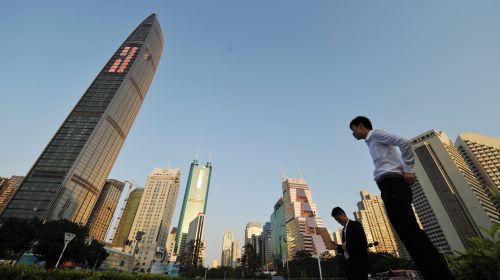SHANGHAI (AP) ― Chinese leaders are scrambling to shore up flagging economic growth as exports weaken, abruptly reversing course after they spent two years struggling to cool an overheated expansion and surging inflation.
In the latest sign the world’s No. 2 economy is weakening faster than thought, a business index released Thursday showed manufacturing contracted for the first time in nearly three years. A day earlier, Beijing eased credit curbs in a bid to spur business activity.
Struggling to keep a lid on inflation, Beijing had balked at moving to stimulate the economy despite signs the boom that followed a recession-fighting lending spree has petered out. But new evidence of a sudden slowdown has forced a nervous Beijing to quickly shift course.
 |
Two businessmen talk in the Chinese city of Shenzhen in Guangdong province, Wednesday. (AFP-Yonhap News) |
“The economy is sagging under the weight of this year’s credit tightening,” Alistair Thornton, China analyst at IHS Global Insight said in a research note.
“The message is clear: the economy is slowing much faster than expected and the government has stepped into the ring. The loosening campaign has begun.”
The European debt crisis and feeble U.S. recovery have weakened demand in China’s biggest export market, while at home efforts to curb inflation by cooling the property market are hurting a wide range of industries heavily dependent on housing and other construction.
The purchasing managers index of the China Federation of Logistics and Purchasing fell an greater-than-expected 1.4 percentage points to 49 in November, well below the 50-level that signifies expansion. That was the first contraction in manufacturing activity since early 2009.
China’s economic growth eased to a still-robust 9.1 percent in the quarter ending in September from 9.5 the previous quarter. But indicators showing export industries and some other areas of the economy were cooling more sharply raised fears of job losses and possible unrest.
Analysts have expected Beijing to loosen lending after inflation eased to 5.5 percent in October from a three-year high and a surge in housing prices leveled off. On Wednesday, the central bank reduced bank reserve levels to release money for lending and help shore up growth.
Another manufacturing survey by HSBC showed an even steeper decline, with its PMI dropping to 47.7 in November from 51.0 in October.
“The data points to a sharp deterioration in business conditions across the Chinese manufacturing sector. Combined with a faster-than-expected easing in inflation, this implies that growth is set to overtake inflation as Beijing’s top policy concern,’’ said HSBC economist Qu Hongbin.
Although China is striving to shift its economy toward greater dependence on consumer demand, rather than exports or investment, those remain key drivers in this developing economy.
China’s export growth has fallen steadily since hitting a peak of nearly 36 percent in March. Its monthly trade surplus with the 27-nation European Union fell 10.3 percent from a year earlier to $13 billion in October as countries that use the euro common currency struggle to contain a sovereign debt crisis.
The federation said that most measures in the purchasing managers’ survey were lower, with the exception of imports, which rose a scant 0.3 percentage point from the month before, and finished goods inventories, which rose a substantial 2.8 percentage points.
“China’s economic growth will continue to weaken, as shown by the decline in purchase orders and producer prices, which reflect overall lower market demand,” federation analyst Zhang Liqun said in the report.
But he forecast there would be no major decline.
Areas still showing expansion included tobacco, oil processing and the coking industry and garments, while chemicals, equipment manufacturing, computers and communications equipment and electronics all weakened, the report showed.
Overall demand for consumer goods remained relatively strong, reflecting growing affluence among the huge Chinese population as inland areas that previously lagged the rich coastal areas see a manufacturing boom aimed at serving those huge markets.
China has resisted easing its lending curbs out of fear that opening the spigots might revive an outright investment boom and re-ignite inflation.
Those fears remain, says Patrick Chovanec, an associate professor at Tsinghua University’s School of Economics and Management in Beijing, but they have been overshadowed by the greater alarm over a potential slump as conditions worsen overseas.
“They’re stuck,” he said of China’s policymakers, pointing to a comment by Vice Premier Wang Qishan to U.S. trade negotiators last week.
That’s what Wang meant by saying that “an unbalanced recovery is better than a balanced recession.”








![[Today’s K-pop] Blackpink’s Jennie, Lisa invited to Coachella as solo acts](http://res.heraldm.com/phpwas/restmb_idxmake.php?idx=644&simg=/content/image/2024/11/21/20241121050099_0.jpg)